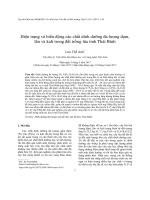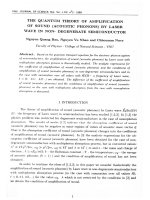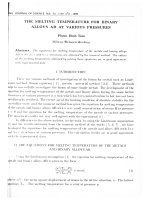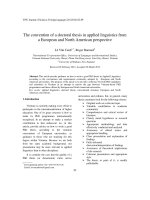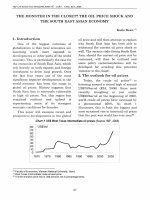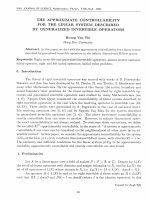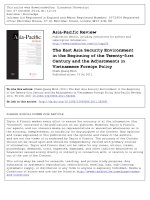DSpace at VNU: The homomorphisms between the Dickson-Mùi algebras as modules over the Steenrod algebra
Bạn đang xem bản rút gọn của tài liệu. Xem và tải ngay bản đầy đủ của tài liệu tại đây (142.36 KB, 4 trang )
C. R. Acad. Sci. Paris, Ser. I 348 (2010) 1001–1004
Contents lists available at ScienceDirect
C. R. Acad. Sci. Paris, Ser. I
www.sciencedirect.com
Topology
The homomorphisms between the Dickson–Mùi algebras as modules over
the Steenrod algebra ✩
Homorphismes entre l’algèbre de Dickson–Mùi comme module sur l’algèbre de Steenrod
Nguyễn H.V. Hư ng
Department of Mathematics, Vietnam National University, Hanoi, 334 Nguyễn Trãi Street, Hanoi, Viet Nam
a r t i c l e
i n f o
a b s t r a c t
Article history:
Received 27 April 2010
Accepted after revision 30 July 2010
Presented by Christophe Soulé
The Dickson–Mùi algebra consists of all invariants in the mod p cohomology of an
elementary abelian p-group under the general linear group. It is a module over the
Steenrod algebra, A. We determine explicitly all the A-module homomorphisms between
the Dickson–Mùi algebras and all the A-module automorphisms of these algebras.
© 2010 Académie des sciences. Published by Elsevier Masson SAS. All rights reserved.
r é s u m é
L’algèbre de Dickson–Mùi consiste en les invariants sous l’action du groupe linéaire dans
l’algèbre de cohomologie modulo p d’un p-groupe abélien élémentaire. C’est un module
sur l’algèbre de Steenrod A. Nous déterminons explicitement tous les homorphismes Alinéaires entre ces algèbres ainsi que leurs automorphismes (A-linéaires).
© 2010 Académie des sciences. Published by Elsevier Masson SAS. All rights reserved.
1. Statement of results
Let V = Vs be an elementary abelian p-group of rank s, where p is a prime. Then V can also be regarded as an sdimensional vector space over F p , the prime field of p elements. Let H ∗ (V) denote the mod p cohomology of (a classifying
space B V of) the group V. As it is well known
H ∗ (V) ∼
=
p = 2,
F2 [x1 , . . . , xs ],
E (e 1 , . . . , e s ) ⊗ F p [x1 , . . . , xs ], p > 2.
Here (x1 , . . . , xs ) is a basis of H 1 (V) = Hom(V, F p ) when p = 2, or a basis of H 2 (V) and xi = β(e i ) for 1 i s with β the
Bockstein homomorphism when p > 2.
The general linear group GL(V) ∼
= GL(s, F p ) acts regularly on V and therefore on H ∗ (V). The Dickson algebra, which
was first studied and explicitly computed by L.E. Dickson [3], is the algebra of all invariants of F p [x1 , . . . , xs ] under the
action of GL(V). The invariant algebra H ∗ (V)GL(V) was explicitly computed by H. Mùi [9] for p > 2. We call H ∗ (V)GL(V) the
Dickson–Mùi algebra and denote it by D (V), or simply by D s , in the both cases p = 2 and p an odd prime.
✩
The work was supported in part by a grant of the NAFOSTED.
E-mail address:
1631-073X/$ – see front matter
doi:10.1016/j.crma.2010.07.032
©
2010 Académie des sciences. Published by Elsevier Masson SAS. All rights reserved.
1002
N.H.V. Hư ng / C. R. Acad. Sci. Paris, Ser. I 348 (2010) 1001–1004
Being the cohomology of the classifying space B V, the group H ∗ (V) is equipped with a structure of module over the
mod p Steenrod algebra, A = A p . The actions of GL(V) and A upon H ∗ (V) commute with each other. Therefore, the
Dickson–Mùi algebra inherits a structure of module over the Steenrod algebra from H ∗ (V).
Let D (V) or D s be the augmentation ideal of all positive degree elements in the Dickson–Mùi algebra D s = D (V). We call
it the reduced Dickson–Mùi algebra. Let trn,r : D n → D r and Ress,n : D s → D n denote the transfer and the restriction on the
Dickson–Mùi algebra that will be defined in detail in Section 2 respectively. Let U and W be respectively F p -vector spaces of
dimensions r and n. The above two homomorphisms are also denoted by trW,U : D (W) → D (U) and ResV,W : D (V) → D (W)
respectively.
Theorem 1.1. The A-module homomorphisms
trn,r Ress,n |1
n
min{r , s}
form a basis of the vector space HomA ( D s , D r ) of all A-module homomorphisms from D s to D r . In particular, dimF p HomA ( D s , D r ) =
min{r , s}.
The main ingredients of our proof are as follows: Let U and V be F p -vector spaces of dimensions r and s respectively.
First, according to a theorem by Carlsson [2] for p = 2 and by Miller [8] for p odd prime, H ∗ (U) is injective in the
category of unstable A-modules. Hence, each A-module homomorphism f : D (V) → D (U) ⊂ H ∗ (U) can be extended to an
A-module homomorphism ˆf : H ∗ (V) → H ∗ (U). Secondly, by a theorem of Adams, Gunawardena and Miller [1], ˆf can be
expressed as
ˆf = λ1 ϕ ∗ + · · · + λk ϕ ∗ ,
1
k
where λi ∈ F p and ϕi∗ is the homomorphism induced in cohomology by some linear map ϕi : U → V for any i. Then ϕi∗ is
a homomorphism of A-algebras. Finally, the restrictions and the transfers are taken into account when we recognize the
relation between the terms λi ϕi∗ ’s, especially in case Im(ϕi∗ ) = H ∗ (U).
By means of the A-module decomposition D s = F p · 1 ⊕ D s , we get the following:
Corollary 1.2. The A-module homomorphisms
trn,r Ress,n |0
n
min{r , s}
form a basis of the vector space HomA ( D s , D r ) of all A-module homomorphisms from D s to D r . In particular, dimF p HomA ( D s , D r ) =
min{r , s} + 1.
Note that tr0,r Ress,0 simply maps 1 ∈ D s to 1 ∈ D r and vanishes on D s .
Let us study the map
θ : Hom(U, V) → HomA D (V), D (U) ,
gϕ∗,
ϕ→
g ∈GL(U∗ )/GL(U∗ ,ϕ ∗ H 1 (V))
where g runs over a set of left coset representatives of GL(U∗ , ϕ ∗ H 1 (V)) in GL(U∗ ). Here GL(U∗ , ϕ ∗ H 1 (V)) denotes the subgroup of GL(U∗ ) consisting of all isomorphisms U∗ → U∗ that map ϕ ∗ H 1 (V) to itself. By using Definition 2.1 of transfer, we
get θ(ϕ ) = trW,U ResV,W , where W denotes the dual F p -vector space of ϕ ∗ H 1 (V). Obviously, Ker(ϕ ) = {u | u , ϕ ∗ H 1 (V) = 0}.
Hence, we observe that θ(ϕ ) = θ(ψ) for ϕ , ψ ∈ Hom(U, V) if and only if Kerϕ ∼
= Kerψ , or equivalently Imϕ ∼
= Imψ . We write
ϕ ∼ ψ to say that this condition is valid. It is easy to see that (Hom(U, V)/ ∼) ∼
= GL(V)\Hom(U, V)/GL(U).
Theorem 1.1 and Corollary 1.2 can be re-expressed in the following formulation: The map θ induces two isomorphisms
of vector spaces
∼
=
F p GL(V)\Hom(U, V)/GL(U) −→ HomA D (V), D (U) ,
∼
=
F p GL(V)\Hom(U, V)/GL(U) /F p 0 −→ HomA D (V), D (U) .
In order to get the second isomorphism from the first one, we observe that θ(F p 0) is exactly the subspace of homomorphisms that vanish on D (V).
For U = V, the map θ induces two isomorphisms of algebras
∼
=
F p GL(V)\End(V)/GL(V) −→ EndA D (V) ,
∼
=
F p GL(V)\End(V)/GL(V) /F p 0 −→ EndA D (V) .
N.H.V. Hư ng / C. R. Acad. Sci. Paris, Ser. I 348 (2010) 1001–1004
1003
Note added in proof. The following problem is probably something of interest.
Problem. Find the conditions on subgroups G of GL(U) and H of GL(V) respectively, under which there is an isomorphism
of F p -vector spaces
F p H \Hom(U, V)/G ∼
= HomA H ∗ V
H
, H ∗ (U)G ,
and an isomorphism of algebras
F p H \End(V)/ H ∼
= EndA H ∗ (V) H .
Note that these isomorphisms happen for G = {1}, H = {1} by the theorem of Adams–Gunawardena–Miller, and for
G = GL(U), H = GL(V) by the main result of this note.
The commutativity relation of the transfer and the restriction is given as follows:
Proposition 1.3.
(i) Resn,r tr s,n = tr s−n+r ,r Ress,s−n+r , for n
(ii) trn,r Ress,n = Ress−n+r ,r tr s,s−n+r , for n
max{r , s}.
min{r , s}.
Theorem 1.4. Let F p [t ] be the polynomial algebra on an indeterminate t. There are isomorphisms of algebras
(i) EndA ( D s ) ∼
= F p [t ]/(t s+1 ),
(ii) EndA ( D s ) ∼
= F p [t ]/(t s ),
which send tr s−1,s Ress,s−1 to t.
The vector space HomA ( D s , D r ) is equipped with a bimodule structure: It is a right module over EndA ( D s ) and a
left module over EndA ( D r ). By passing to the quotient, HomA ( D s , D r ) is also a bimodule: a right module over EndA ( D s )
and a left module over EndA ( D r ). Set u i = trmin(r ,s)−i ,r Ress,min(r ,s)−i for i 0. Denote t = tr s−1,s Ress,s−1 in EndA ( D s ) or in
EndA ( D s ), and t = trr −1,r Resr ,r −1 in EndA ( D r ) or in EndA ( D r ).
Proposition 1.5. The structures of the bimodules HomA ( D s , D r ) ∼
=
by
min(r ,s)
Fp ui
i =0
and HomA ( D s , D r ) ∼
=
min(r ,s)−1
Fp ui
i =0
are given
(i) u i t = u i +1 ,
(ii) t u i = u i +1 ,
where u min(r ,s)+1 = 0 in HomA ( D s , D r ) and u min(r ,s) = 0 in HomA ( D s , D r ).
Theorem 1.6. An A-module endomorphism f : D s → D s is an automorphism if and only if
s −1
f = λid D s +
λn trn,s Ress,n (λn ∈ F p ),
n =1
where λ is a non-zero scalar. In particular, there are exactly ( p − 1) p s−1 automorphisms of the A-module D s .
Theorem 1.7. If an A-module endomorphism f : D s → D s is non-zero on the least positive degree generator of the Dickson–Mùi
algebra, then it is an automorphism.
Corollary 1.8. The reduced Dickson–Mùi algebra is an indecomposable module over the Steenrod algebra.
From this result, the problem of classifying the indecomposable modules over the Steenrod algebra should be of interest.
Theorem 1.9. Let f : D s → D r be a homomorphism of A-algebras. Then
f =
λRess,r , r s,
0,
r > s,
where λ is a scalar.
1004
N.H.V. Hư ng / C. R. Acad. Sci. Paris, Ser. I 348 (2010) 1001–1004
alg
Corollary 1.10. Let EndA ( D s ) be the algebra of all A-algebra endomorphisms of D s . Then there is an isomorphism of algebras
EndA ( D s ) ∼
= Fp .
alg
2. Transfer and restriction on the Dickson–Mùi algebras
Let U and V be F p -vector spaces of respectively dimensions r and s with r s. Then V can be regarded as a direct sum
V = U ⊕ V of U and some vector space V . Therefore, H ∗ (U) is thought of as a subalgebra of H ∗ (V). Recall that
H ∗ (U) ∼
=
S (U∗ ),
E (U∗ ) ⊗ S (βU∗ ),
p = 2,
p > 2,
where S (X) and E (X) denote the symmetric algebra and the exterior algebra on the vector space X, with β the Bockstein
homomorphism for p > 2.
If g : V∗ → V∗ is a linear isomorphism, then g = g |U∗ is an isomorphism from U∗ to g U∗ . It also gives rise to an
isomorphism g : H ∗ (U) → g H ∗ (U). Let GL(V∗ , U∗ ) denote the subgroup of GL(V∗ ) consisting of all isomorphisms V∗ → V∗
that map U∗ to itself.
Definition 2.1. The transfer trU,V : H ∗ (U)GL(U) → H ∗ (V)GL(V) is given by
trU,V ( Q ) =
gQ ,
g ∈GL(V∗ )/GL(V∗ ,U∗ )
for Q ∈ H ∗ (U)GL(U) , where g runs over a set of left coset representatives of GL(V∗ , U∗ ) in GL(V∗ ).
Definition 2.2. The restriction from D (V) to D (U), denoted by ResV,U : D (V) → D (U) or by Ress,r : D s → D r for r = dim U
dim V = s, is the homomorphism i ∗U,V : H ∗ (V)GL(V) → H ∗ (U)GL(U) induced by an inclusion i U,V : U → V.
The restriction ResV,U does not depend on the choice of the inclusion i U,V .
The contains of this note will be published in detail elsewhere.
3. Final remarks
There is some overlap between Kechagias’ manuscript [7] and this note, such as the dimension of EndA ( D s ) and the
indecomposability of D s .
However, it should be noted that the results of the note are general, more precise, while our proof is less technical and
more conceptual.
Our proof is essentially based on the results of the papers [4–6].
References
[1] J.F. Adams, J.H. Gunawardena, H.R. Miller, The Segal conjecture for elementary abelian p-groups, Topology 24 (1985) 435–460. MR0816524.
[2] G. Carlsson, G.B. Segal’s Burnside ring conjecture for ( Z /2)k , Topology 22 (1983) 83–103. MR0682060.
[3] L.E. Dickson, A fundamental system of invariants of the general modular linear group with a solution of the form problem, Trans. Amer. Math. Soc. 12
(1911) 75–98. MR1500882.
[4] Nguyễn H.V. Hư ng, The action of the Steenrod squares on the modular invariants of linear groups, Proc. Amer. Math. Soc. 113 (1991) 1097–1104.
MR1064904.
[5] Nguyễn H.V. Hư ng, Pham A. Minh, The action of the mod p Steenrod operations on the modular invariants of linear groups, Vietnam J. Math. 23 (1995)
39–56. MR1367491.
[6] Nguyễn H.V. Hư ng, F.P. Peterson, Spherical classes and the Dickson algebra, Math. Proc. Cambridge Philos. Soc. 124 (1998) 253–264. MR1631123.
[7] N.E. Kechagias, A Steenrod–Milnor action ordering on Dickson invariants, manuscript posted on his webpage www.math.uoi.gr/~nondas_k.
[8] H.R. Miller, The Sullivan conjecture on maps from classifying spaces, Ann. of Math. (2) 120 (1984) 39–87, MR0750716.
`
[9] Huynh
Mùi, Modular invariant theory and cohomology algebras of symmetric groups, J. Fac. Sci. Univ. Tokyo Sect. IA Math. 22 (1975) 319–369.
MR0422451.

